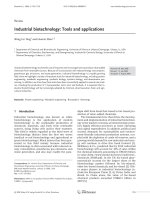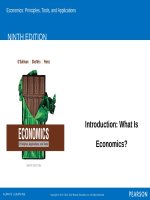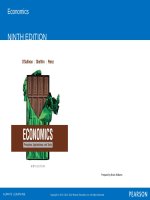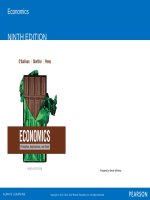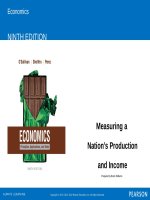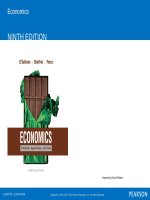Economics principles tools and applications 9th by sullivan sheffrin perez chapter 20
Bạn đang xem bản rút gọn của tài liệu. Xem và tải ngay bản đầy đủ của tài liệu tại đây (830.85 KB, 43 trang )
Economics
NINTH EDITION
Chapter 20
Insert Cover picture from 9
edition
th
Elasticity: A
Measure of
Responsiveness
Copyright © 2015, 2012, 2009 Pearson Education, Inc. All Rights Reserved
Learning Objectives
20.1 List the determinants of the price elasticity of demand
20.2 Use price elasticity of demand to predict changes in quantity and total revenue
20.3 Explain how the price elasticity of demand varies along a linear demand curve
20.4 Define the income elasticity and cross-price elasticity of demand
20.5 List the determinants of the price elasticity of supply
20.6 Use demand and supply elasticities to predict changes in equilibrium prices
Copyright © 2015, 2012, 2009 Pearson Education, Inc. All Rights Reserved
20.1 THE PRICE ELASTICITY OF
DEMAND (1 of 9)
●
Price elasticity of demand (Ed)
A measure of the responsiveness of the quantity demanded to changes in price; equal to the absolute value of the percentage change in quantity demanded divided
by the percentage change in price.
Copyright © 2015, 2012, 2009 Pearson Education, Inc. All Rights Reserved
20.1 THE PRICE ELASTICITY OF
DEMAND (2 of 9)
Computing Percentage Changes and Elasticities
Insert Table 20.1
Copyright © 2015, 2012, 2009 Pearson Education, Inc. All Rights Reserved
20.1 THE PRICE ELASTICITY OF
DEMAND (3 of 9)
Price Elasticity and the Demand Curve
● Elastic demand
The price elasticity of demand is greater than one, so the percentage change in
quantity exceeds the percentage change in price.
Copyright © 2015, 2012, 2009 Pearson Education, Inc. All Rights Reserved
20.1 THE PRICE ELASTICITY OF
DEMAND (4 of 9)
Price Elasticity and the Demand Curve
● Inelastic demand
The price elasticity of demand is less than one, so the percentage change
in quantity is less than the percentage change in price.
Copyright © 2015, 2012, 2009 Pearson Education, Inc. All Rights Reserved
20.1 THE PRICE ELASTICITY OF
DEMAND (5 of 9)
Price Elasticity and the Demand Curve
● Unit elastic demand
The price elasticity of demand is one, so the percentage change in quantity equals
the percentage change in price.
Copyright © 2015, 2012, 2009 Pearson Education, Inc. All Rights Reserved
20.1 THE PRICE ELASTICITY OF
DEMAND (5 of 9)
Price Elasticity and the Demand Curve
●
Perfectly inelastic demand
The price elasticity of demand is zero.
Copyright © 2015, 2012, 2009 Pearson Education, Inc. All Rights Reserved
20.1 THE PRICE ELASTICITY OF
DEMAND (6 of 9)
Price Elasticity and the Demand Curve
●
Perfectly elastic demand
The price elasticity of demand is infinite.
Copyright © 2015, 2012, 2009 Pearson Education, Inc. All Rights Reserved
20.1 THE PRICE ELASTICITY OF
DEMAND (7 of 9)
Elasticity and the Availability of Substitutes
TABLE 20.2 Price Elasticities of Demand for Selected Products1
Product
Inelastic
Unit elastic
Elastic
Price Elasticity of Demand
Salt
0.1
Food (wealthy countries)
0.15
Weekend canoe trips
0.19
Water
0.2
Coffee
0.3
Physician visits
0.25
Sport fishing
0.28
Gasoline (short run)
0.25
Eggs
0.3
Cigarettes
0.3
Food (poor countries)
0.34
Shoes and footwear
0.7
Gasoline (long run)
0.6
Housing
1.0
Fruit Juice
1.0
Automobiles
1.2
Foreign travel
1.8
Motorboats
2.2
Restaurant meals
2.3
Air travel
2.4
Movies
3.7
Specific brands of coffee
5.6
Copyright © 2015, 2012, 2009 Pearson Education, Inc. All Rights Reserved
20.1 THE PRICE ELASTICITY OF
DEMAND (8 of 9)
Other Determinants of the Price Elasticity of Demand
TABLE 20.3 Determinates of Elasticity
Demand is relatively
Demand is relatively
elastic if …
inelastic if …
Availability of substitutes
There are many substitutes.
There are few substitutes.
Passage of time
a long time passes.
a short time passes.
Fraction of consumer budget
is large.
is small.
Necessity
the product is a luxury.
the product is a necessity.
Factor
Copyright © 2015, 2012, 2009 Pearson Education, Inc. All Rights Reserved
APPLICATION 1
•
A CLOSER LOOK AT THE ELASTICITY OF DEMAND FOR GASOLINE
•
APPLYING THE CONCEPTS #1: How does the elasticity of demand vary over time?
We’ve seen that the demand for gasoline is more elastic in the long run, when consumers have more opportunity to respond to changes in price. A recent study explores two sorts
of response to higher gasoline prices.
•
First, when the price increases, people drive fewer miles, so there are fewer cars on the road.
•
A second response to higher prices is to switch to more fuel-efficient cars.
TABLE 20.4 Gasoline Prices, Traffic Volume, and Fuel Efficiency
Elasticity of
Short Run (1 year)
Long Run (5 years)
Traffic Volume
0.10
0.30
Fuel Efficiency
0.15
0.40
•
Source: Based on Phil Goodwin, Joyce Dargay, and Mark Hanly, “Elasticities of Road Traffic and Fuel Consumption with Respect to Price and Income: A Review,” Transport Review 24, no.3 (2004): 275‒292.
Copyright © 2015, 2012, 2009 Pearson Education, Inc. All Rights Reserved
20.2 USING PRICE ELASTICITY (1 of 10)
Predicting Changes in Quantity
If we have values for two of the three variables in the elasticity formula, we can compute the value of the third. The three variables are:
(1)
the price elasticity of demand itself,
(2)
the percentage change in quantity, and
(3)
the percentage change in price.
Specifically, we can rearrange the elasticity formula:
percentage change in quantity demanded = percentage change in price × Ed
Copyright © 2015, 2012, 2009 Pearson Education, Inc. All Rights Reserved
20.2 USING PRICE ELASTICITY (2 of 10)
Beer Prices and Highway Deaths
•
We can use the concept of price elasticity to predict the effects of a change in the price of beer on drinking and highway deaths among young
adults.
•
The price elasticity of demand for beer among young adults is about 1.30.
•
If a state imposes a beer tax that increases the price of beer by 10 percent, we would predict that beer consumption will decrease by 13 percent:
•
•
%change in quantity demanded = %change in price*Ed =10% * 1.30=13%
The number of highway deaths among young adults is roughly proportional to their beer consumption, so the number of deaths will also decrease
by 13 percent.
Copyright © 2015, 2012, 2009 Pearson Education, Inc. All Rights Reserved
20.2 USING PRICE ELASTICITY (3 of 10)
Cigarette Prices and Teenagers
•
Another ongoing policy objective is to reduce smoking by teenagers.
•
Under the 1997 federal tobacco settlement, cigarette prices increased by about 62 cents per pack, a percentage increase of about 25 percent.
•
The demand for cigarettes by teenagers is elastic, with an elasticity of 1.3
•
Therefore, a 25 percent price hike will reduce teen smoking by 32.5%
•
•
%change in quantity demanded = 25%*1.30 = 32.5%
About half the decrease in consumption occurs because fewer teenagers will become smokers, and the other half occurs because each teenage
smoker will smoke fewer cigarettes.
Copyright © 2015, 2012, 2009 Pearson Education, Inc. All Rights Reserved
20.2 USING PRICE ELASTICITY (4 of 10)
•
Price Elasticity and Total Revenue
Total revenue
●
The money a firm generates from selling its product.
•
total revenue = price per unit × quantity sold
•
What happens to Total Revenue if price goes up?
•
•
Good News: You get more for each unit sold
•
Bad News: You sell fewer units
Effect on TR depends on which effect is bigger, i.e. whether the price elasticity is less than or greater than one.
Copyright © 2015, 2012, 2009 Pearson Education, Inc. All Rights Reserved
20.2 USING PRICE ELASTICITY (5 of 10)
TABLE 20.5 Price and Total Revenue with Different Elasticities of Demand
Elastic Demand: Ed = 2.0
Price
Quantity Sold
Total Revenue
$10
100
$1,000
11
80
880
Inelastic Demand: Ed = 0.50
Price
Quantity Sold
Total Revenue
100
10
$1,000
120
9
1,080
Copyright © 2015, 2012, 2009 Pearson Education, Inc. All Rights Reserved
20.2 USING PRICE ELASTICITY (6 of 10)
•
Elastic versus Inelastic Demand
TABLE 20.6 Price Elasticity and Total Revenue
Elastic Demand: Ed > 1.0
If price …
Total revenue …
Because the percentage change in quantity is …
↑
↓
Larger than the percentage change in price.
↓
↑
Larger than the percentage change in price.
Inelastic Demand: Ed < 1.0
If price …
Total revenue …
Because the percentage change in quantity is …
↑
↑
Smaller than the percentage change in price.
↓
↓
Smaller than the percentage change in price.
Copyright © 2015, 2012, 2009 Pearson Education, Inc. All Rights Reserved
20.2 USING PRICE ELASTICITY (7 of 10)
Market versus Brand Elasticity
•
Recall the chapter opener about the coffee producer.
•
The question is whether a price cut will increase or decrease the firm’s total revenue.
•
Although general demand for coffee is inelastic (price elasticity of demand = 0.3) the demand for specific brands is elastic (price elasticity of
demand = 5.6)
•
Therefore, a price cut on a specific brand of coffee will increase a firm’s total revenue.
Copyright © 2015, 2012, 2009 Pearson Education, Inc. All Rights Reserved
20.2 USING PRICE ELASTICITY (8 of 10)
Bus Fares and Deficits
•
In every large city in the United States, the public bus system runs a deficit Here is the exchange between two city officials:
•
Buster: “A fare increase is a great idea. We’ll collect more money from bus riders, so revenue will increase, and the deficit will shrink.”
•
Bessie: “Wait a minute, Buster. Haven’t you heard about the law of demand? The increase in the bus fare will decrease the number of passengers taking buses, so
we’ll collect less money, not more, and the deficit will grow.”
•
Who’s right? It depends on the price elasticity of demand for bus ridership.
•
The price elasticity of demand for bus ridership in the typical city is 0.33, meaning that a 10 percent increase in fares will decrease ridership by only about 3.3 percent.
•
Because demand for bus travel is inelastic, the good news associated with a fare hike (10 percent more revenue per rider) will dominate the bad news (3.3 percent fewer
riders), and total fare revenue will increase.
•
In other words, an increase in fares will reduce the transit deficit, so Buster is right.
Copyright © 2015, 2012, 2009 Pearson Education, Inc. All Rights Reserved
20.2 USING PRICE ELASTICITY (9 of 10)
Why Are Bumper Crops Bad News for Farmers?
•
Suppose favorable weather generates a “bumper crop” for soybeans that is 30 percent larger than last year’s harvest.
•
The bumper crop brings good news and bad news for farmers.
The good news is that they will sell more bushels of soybeans.
The bad news is that the increase in supply will decrease the equilibrium
price of soybeans, so farmers will get less money per bushel.
•
Unfortunately for farmers, the demand for soybeans and many other agricultural products is inelastic.
•
With inelastic demand, consumers need a large price reduction to buy more of the product. Therefore, to increase the quantity demanded of soybeans by 30
percent to meet the higher supply, the price must decrease by more than 30 percent.
Copyright © 2015, 2012, 2009 Pearson Education, Inc. All Rights Reserved
20.2 USING PRICE ELASTICITY (10 of 10)
Antidrug Policies and Property Crime
•
What is the connection between antidrug policies and property crimes
•
The government uses various policies to restrict the supply of illegal drugs, and the decrease in supply increases the equilibrium price.
•
Because the demand for illegal drugs is inelastic, the increase in price will increase total spending on illegal drugs.
•
A drug addict supports his or her habit by stealing, will commit more property crimes to pay for the drugs.
•
There is a trade off. A policy that increases drug prices, will reduce consumption, but will also increase the amount of crime committed by drug addicts who
continue to abuse drugs.
Copyright © 2015, 2012, 2009 Pearson Education, Inc. All Rights Reserved
APPLICATION 2
VANITY PLATES AND THE ELASTICITY OF DEMAND
•
APPLYING THE CONCEPTS #2: How does an increase in price affect total expenditures?
•
The radio quiz show Wait Wait . . . Don’t Tell Me! recently asked the following question: Which state has the highest number of vanity license plates?
•
The correct answer is Virginia, where over 10 percent of cars have vanity license plates such as 10SNE1 and GLBLWRMR.
•
An economist might have extended the question to ask why there are so many vanity plates in Virginia.
•
Although Virginians may be unusually vain, a more plausible explanation is that the price of vanity plates is only $10, or about one-third of the average price
in the United States.
•
According to a recent study, the demand for vanity plates in Virginia is inelastic, with a price elasticity of demand equal to 0.26.
•
If the state increased the price, the total revenue from vanity plates would increase.
Copyright © 2015, 2012, 2009 Pearson Education, Inc. All Rights Reserved
20.3 ELASTICITY AND TOTAL REVENUE FOR A LINEAR DEMAND CURVE
(1 of 3)
Price Elasticity along a Linear Demand Curve
Demand is elastic along the upper half of a linear demand curve (between points a and b on
the total- revenue curve).
Demand is inelastic along the lower half of a linear demand curve (between points b and c).
Total revenue is maximized at the midpoint of a linear demand curve (point u), where
demand is unit elastic.
Copyright © 2015, 2012, 2009 Pearson Education, Inc. All Rights Reserved
20.3 ELASTICITY AND TOTAL REVENUE FOR A LINEAR DEMAND CURVE
(2 of 3)
Elasticity and Total Revenue for a Linear Demand Curve
•
Panel B of Figure 20.2 shows the relationship between total revenue and the quantity sold for the linear demand curve.
•
Demand is elastic along the upper half of a linear demand curve, which means that a decrease in price will increase the quantity sold by a larger percentage
amount. As a result, total revenue will increase, as shown by the positively sloped total-revenue curve between points a and b.
•
In contrast, demand is inelastic along the lower half of a linear demand curve, which means that a decrease in price will increase the quantity sold by a smaller
percentage amount. As a result, total revenue will decrease, as shown by the negatively sloped total-revenue curve between points b and c.
•
The total-revenue curve reaches its maximum at the midpoint of the linear demand curve, where demand is unit elastic. In Figure 20.2, demand is unit elastic at
point u on the demand curve, so total revenue reaches its maximum at $1,250 at point b on the total-revenue curve.
Copyright © 2015, 2012, 2009 Pearson Education, Inc. All Rights Reserved
